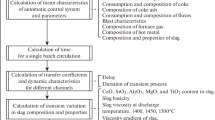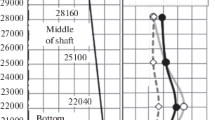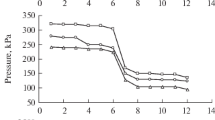The article considers principles of creating a logical dynamic model of the course of blast furnace smelting in a real time regime. It is based on actual operating behavior and its innovation, and data are provided for operation in this area that form the basis of this model or are used for its creation. Some blast furnace transient processes are studied. As a result of this, dependences are described for the effect of blast composition and parameters on molten product composition, and also the effect of charge composition on the gas dynamic resistance of a charge bed. Software is created demonstrating the relationships described with the aim of practical implementation of the model in question. Features of the blast furnace are provided for the transient processes considered, and practical recommendations are made for certain aspects of smelting.





Similar content being viewed by others
References
I. G. Tovarovskii, Blast Furnace Smelting, Porogi, Dnepropetrovsk (2009).
V. A. Chlakovich, E. I. Reikh, V. M. Sholeninov, et al., “Study of blast furnace dynamics,” Stal, No. 1, 9–14 (1975).
Z. Zhou, H. Zhu, A. Yu, and P. Zulli, “Numerical investigation of the transient multiphase flow in an ironmaking blast furnace,” ISIJ Int., 50, No. 4, 515–523 (2010).
S. Natsui, H. Nogami, S. Ueda, et al., “Simultaneous three-dimensional analysis of gas-solid flow in blast furnace by combining discrete element method and computational fluid dynamics,” ISIJ Int., 51, No. 1, 41–50 (2011).
L. S. Mkrtchan, A. F. Rebeko, Yu. V. Serov, et al., “Study of blast furnace dynamics,” Stal, No. 11, 981–986 (1975).
B. H. Xu, A. B. Yu, S. J. Chew, and P. Zulli, “Numerical simulation of the gas-solid flow in a bed with lateral gas blasting,” Powder Technol., 109, No. 1–3, 13–26 (2000).
S. Ueda, S. Natsui, H. Nogami, et al., “Recent progress and future perspective on mathematical modeling of blast furnace,” ISIJ Int., 50, No. 7, 914–923 (2010).
D. Bulter and K. Mattheis, “Blast furnace process control,” Chern. Met., No. 22, 3–11 (1970).
K. Mattheis, D. Bulter, and E. Schurmann, “Blast furnace transient regime,” Chern. Met., No. 22, 31–38 (1974).
I. F. Kurunov, V. A. Dobroskok, and V. G. Makienko, “Effect of blast furnace dimensions and number of dynamic tappings on control channel dynamic characteristics,” in: Problems of Automatic Control of Blast-Furnace Production: Coll. Works, Inst. of Automatics, Kiev (1973), Iss. 3, pp. 85–87.
V. I. Moikin, N. M. Babushkin, and B. A. Bokovikov, “Blast furnace dynamic characteristics from mathematical modeling results,” in: Questions of Cast Iron Production in Blast Furnaces: Coll. Sci. Works, MChM SSSR (IChM), Metallurgiya, Moscow (1984), pp. 46–52.
Jian Xu, Wu Sheng-li, Guo Xin-ying, and Du Kai-ping, “Numerical simulation on dynamic and static holdups of powder inside pre-reduction shaft furnace,” in: Proc. 6th Int. Congr. on Science and Technology of Ironmaking, Rio de Janeiro, RJ, Brazil, Oct. 14–18, 2012, pp. 414–424.
Yu. N, Ovchinnikov, V. I. Moikin, N. A. Spirin, and B. A. Bokovikov, Transient Processes and Improvement of Blast Furnace Efficiency, Metallurgiya, Chelyabinsk (1989).
M. Hatano, K. Kurita, H. Yamaoka, and T. Yokoi, “Investigation of blow-in operation through the blast furnace dynamic model,” Tetsu-to-Hagane, 68, No. 15, 2369–2376 (1982).
S. Taguchi, H. Kubo, N. Tsuchiya, et al., “Development of a mathematical model of silicon transfer via SiO in the blast furnace,” Tetsu-to-Hagane, 68, No. 15, 2303–2310 (1982).
J.-I. Yagi, “Mathematical model of blast furnace progress and application to new technology development,” in: Proc. 6th Int. Congr. on Science and Technology of Ironmaking, Rio de Janeiro, RJ, Brazil, Oct. 14–18, 2012, pp. 1660–1674.
B. I. Kitaev, Yu. G. Yaroshenko, E. L. Sukhanov, et al., Blast Furnace Heat Engineering, Metallurgiya, Moscow (1978).
O. P. Oporin, N. A. Spirin, V. L. Terent’ev, et al., Computer Methods for Blast Furnace Process Modeling, UGTUUPI, Ekaterinburg (2005).
N. A. Spirin, V. V. Lavrov, V. Yu. Rybolovlev, et al., Mathematical Modeling of EAF Metallurgical Processes, UIPTs, Ekaterinburg (2014).
A. N. Ramm, Contemporary Blast Furnace Process, Metallurgiya, Moscow (1980).
O. P. Onorin, N. A. Spirin, V. V. Lavrov, et al., “Assessing the shape of the viscoplastic iron-ore zone in a blast furnace,” Steel in Transl., 43, No. 6, 335–340 (2013).
Author information
Authors and Affiliations
Additional information
Translated from Metallurg, No. 2, pp. 47–51, February, 2017.
Rights and permissions
About this article
Cite this article
Onorin, O.P., Spirin, N.A., Istomin, A.S. et al. Features of Blast Furnace Transient Processes. Metallurgist 61, 121–126 (2017). https://doi.org/10.1007/s11015-017-0464-2
Received:
Published:
Issue Date:
DOI: https://doi.org/10.1007/s11015-017-0464-2




